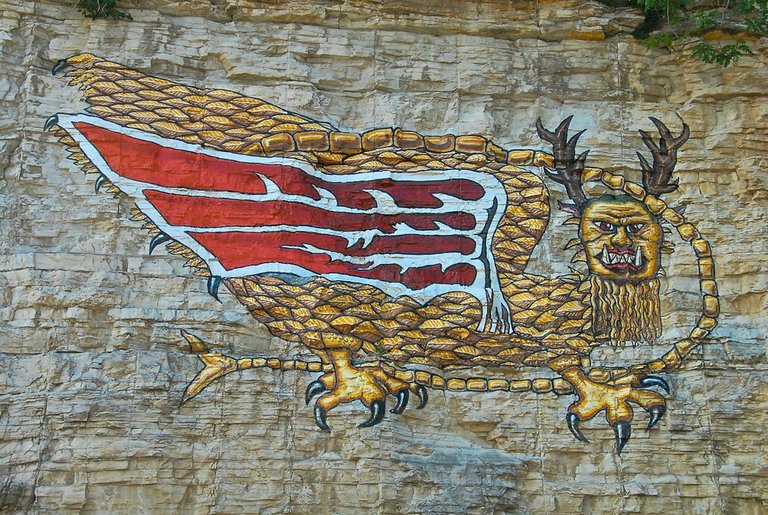
"The picture was cut into the rock a half inch or more, and was originally painted red, black, and blue. It had the head of a bear, large disproportioned teeth, the horns of an elk, the scaly body of a large fish, and a bear's legs ending with eagle's claws. The tail was at least fifty feet long, wound three times around the body, and tipped with a spearhead thrust backward through its hind legs.
"The upper horns were painted red, the lower portion and head were painted black. The wings expanded to the right and left of its head, and the Piasa's body was at least sixteen feet long. Its head and neck were covered with a whiskery mane, and its body...covered with the three colours... In 1820, Captain Gideon Spencer came up the Mississippi River and saw the same picture on the rock. He asked the nearby Indians what it was. They told him it was the Stormbird or Thunderer, and that it had been carved there by an Indian tribe long ago."
"The Mesozoic age of reptiles extended over a hundred million years," said Arthur Loveridge of Harvard University. "Frequently bizarre-looking animals evolved, such as flying saurians (pterosaurs) with combined batlike and dragonlike features, measuring up to twenty feet between wing tips."
U.S. geologist F. V. Hayden stated, "Professor Marsh discovered remains of flying saurians in Kansas Chalk with eighteen to twenty feet between wing tips."
The earth has preserved its record of ancient flying saurians (flying reptiles) and since the beginning of recorded history man has been fascinated with these creatures.
Was there a real Piasa--a flying saurian--hanging by its claws in the cliffs along the Illinois River? The Illini Indian tribe has handed down the following legend.
Long, long ago, when only animals walked the earth, Storm-bird lived in a cave by the river. His cave was lined with the bones of buffalo victims. He would swoop down upon a buffalo herd and drive his terrible claws into the fattest one, carrying it off to his cave.
After our people arrived upon the earth, Storm-bird captured one of our warriors. From that day on, he was a threat to our whole tribe--men, women, and children. A loud roar and a flapping sound signalled that Storm-bird was coming out of his cave. Everyone agreed that something must be done to destroy the monster, but what?
Ouatoga [OO-wa-toe-ga] was our great Chief of the Illinis. He announced to our people that he was determined to find a way to kill the beast. As part of their tribal ritual, he withdrew in solitude to fast and seek a vision. He prayed to the Great Spirit to reveal a way to conquer the Storm-bird.
When Chief Ouatoga returned, he directed all of our people to hide in their tepees. He then dispatched his chosen warriors to the brush surrounding an exposed point of land, directly opposite the cave of the Storm-bird.
Dressed in his Chiefs warbonnet, Ouatoga took his stand upon the point of land, without weapons. Storm-bird could see the Chief. It began to roar! Eyeing our Chief with clenched teeth, it opened its huge weblike wings and charged at the Chief!
Ouatoga stood his ground, chanting his death song! Instantly, the hidden warriors let go their arrows with sharp, pointed flints. The Storm-bird was struck from all sides with a hundred arrows and fell dead!
To honour Chief Ouatoga and in remembrance of the event, a sculpture of the flying Storm-bird was carved into the cliffside and painted by the Illini tribe a long time ago, an exact replica of the terrible beast.
Indians. org Indigenous Peoples Literature
Hi! I am a robot. I just upvoted you! I found similar content that readers might be interested in:
https://indigenouspeoplenet.wordpress.com/2017/02/06/illini-tribe/